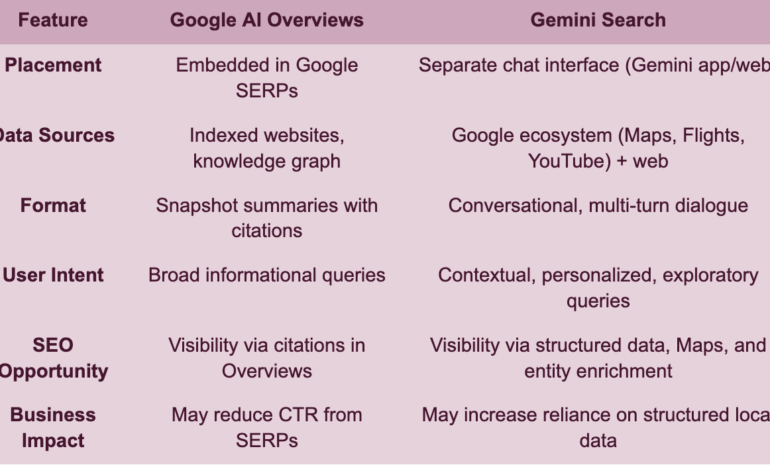For nearly two decades, search engine optimization (SEO) has revolved around one core principle: driving users from search engines to your website. The traditional funnel was simple, rank high in Google’s search results, attract clicks, and convert those visitors.
But in 2024 and beyond, AI-powered summaries are rewriting that playbook. Google’s AI Overviews, Perplexity’s instant answers, and ChatGPT’s conversational recommendations no longer just list links but they provide summarized answers directly in the search interface.
For SaaS SEO providers and multi-location brands, this new model introduces both risks and opportunities. Website traffic is no longer guaranteed, but visibility within AI-generated answers may become the most important ranking factor of all.
How AI Summaries Work
Unlike traditional snippets, AI summaries are generated dynamically by Large Language Models (LLMs). They:
- Aggregate multiple sources: pulling from websites, reviews, directories, and knowledge graphs.
- Synthesize content: creating a natural language summary instead of verbatim quotes.
- Provide citations selectively: sometimes linking back to sources, sometimes not.
- Answer conversationally; adapting to voice and chat-driven interfaces.
Example: Instead of showing 10 blue links for “best Italian restaurants in Chicago,” an AI summary might say:
“Top Italian restaurants in Chicago include RPM Italian, Piccolo Sogno, and Quartino. Reviewers highlight authentic dishes, great wine lists, and convenient downtown locations.”
Notice what’s missing? Your website click-through.
The Impact on Website Traffic
1. Reduced Click-Through Rates (CTR)
AI summaries satisfy user intent without requiring a visit to the source site. This mirrors what already happened with Google’s “zero-click searches,” but on a larger scale.
2. Winner-Takes-Most Visibility
If your brand is cited in the AI summary, visibility can skyrocket. If not, you may lose out entirely, even if your website is well-optimized.
3. Shift in Metrics
Traditional SEO KPIs like organic sessions may decline, while brand mentions, citation frequency, and entity visibility become more relevant.
4. Rise of “Attribution Uncertainty”
Not all AI summaries link back. Brands must adapt to the reality that their content or data may drive visibility without referral traffic.
Why Multi-Location Brands Are Affected Most
Multi-location businesses rely heavily on local search to drive foot traffic. AI summaries often:
- Pull from directories and review platforms (Yelp, TripAdvisor, Google Maps) rather than brand websites.
- Aggregate local data (hours, services, reviews) directly into answers.
- Recommend a handful of businesses rather than providing long lists.
This means location data must be accurate, enriched, and syndicated across ecosystems or your brand risks being invisible in AI-driven summaries.
How SEO Is Changing in the Age of AI
The new SEO it’s about ensuring your brand data feeds AI summaries correctly.
1. Entity-Based Optimization
LLMs think in entities (businesses, products, people, places), not just keywords. Brands must ensure their entities are fully represented in directories, knowledge graphs, and schema markup.
2. Structured Data First
Machine-readable data (schema, attributes, menus, inventory feeds) increases the likelihood of being cited in AI answers.
3. Review Semantics
AI parses review language for context. “Fast service,” “pet-friendly,” or “great for kids” can trigger visibility in conversational queries.
4. Multi-Platform Syndication
AI engines don’t rely on one source. Brands must maintain consistency across Google Business Profiles, Apple Maps, Bing Places, Yelp, and emerging AI aggregators.
5. Measuring New KPIs
Providers should track:
- Citation frequency in AI summaries
- Brand mentions across AI engines
- Cross-platform listing accuracy
- Local visibility via Geo Grid APIs (block-by-block discoverability)
And what about EZOMA?
Ezoma was built for the new SEO era. By syndicating enriched, structured data across 100+ platforms, Ezoma ensures that multi-location brands:
- Appear consistently in AI-generated answers.
- Provide machine-readable attributes that increase citation likelihood.
- Gain visibility across both traditional SERPs and AI discovery engines.
- Track performance using new visibility metrics—not just traffic.
With Ezoma, SaaS SEO providers can shift from “ranking for clicks” to “being recommended in AI summaries.”
AI-powered summaries are reshaping the fundamentals of SEO. Instead of clicks, the new goal is presence: being named, cited, and recommended by AI discovery engines.
For SaaS SEO providers, this means they will need to rethink metrics, syndicate structured data at scale and prepare clients for a post-click SEO landscape where visibility equals influence.
The brands that adapt early will continue to thrive, even if website traffic looks very different from what it used to be.
Clicks are no longer the only SEO goal. Make your clients visible in AI summaries with Ezoma
Structured, syndicated, and AI-ready.


